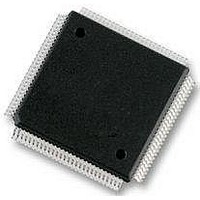MC9S12E128CPV Freescale Semiconductor, MC9S12E128CPV Datasheet - Page 506

MC9S12E128CPV
Manufacturer Part Number
MC9S12E128CPV
Description
Microcontrollers (MCU) 16 Bit 16MHz
Manufacturer
Freescale Semiconductor
Datasheet
1.MC9S12E128CPV.pdf
(606 pages)
Specifications of MC9S12E128CPV
Data Bus Width
16 bit
Program Memory Type
Flash
Program Memory Size
128 KB
Data Ram Size
8 KB
Interface Type
SCI, SPI
Maximum Clock Frequency
25 MHz
Number Of Programmable I/os
92
Number Of Timers
16 bit
Operating Supply Voltage
3.135 V to 5.5 V
Maximum Operating Temperature
+ 85 C
Mounting Style
SMD/SMT
Package / Case
LQFP-112
Minimum Operating Temperature
- 40 C
On-chip Adc
10 bit
On-chip Dac
8 bit, 2 Channel
Lead Free Status / Rohs Status
No RoHS Version Available
Available stocks
Company
Part Number
Manufacturer
Quantity
Price
Company:
Part Number:
MC9S12E128CPVE
Manufacturer:
Freescale Semiconductor
Quantity:
10 000
- Current page: 506 of 606
- Download datasheet (4Mb)
Chapter 17 Interrupt (INTV1)
The interrupt sub-block decodes the priority of all system exception requests and provides the applicable
vector for processing the exception. The INT supports I-bit maskable and X-bit maskable interrupts, a
non-maskable unimplemented opcode trap, a non-maskable software interrupt (SWI) or background debug
mode request, and three system reset vector requests. All interrupt related exception requests are managed
by the interrupt sub-block (INT).
17.1.1
The INT includes these features:
17.1.2
The functionality of the INT sub-block in various modes of operation is discussed in the subsections that
follow.
506
•
•
•
•
•
•
•
•
•
•
•
•
•
•
•
•
Provides two to 122 I-bit maskable interrupt vectors (0xFF00–0xFFF2)
Provides one X-bit maskable interrupt vector (0xFFF4)
Provides a non-maskable software interrupt (SWI) or background debug mode request vector
(0xFFF6)
Provides a non-maskable unimplemented opcode trap (TRAP) vector (0xFFF8)
Provides three system reset vectors (0xFFFA–0xFFFE) (reset, CMR, and COP)
Determines the appropriate vector and drives it onto the address bus at the appropriate time
Signals the CPU that interrupts are pending
Provides control registers which allow testing of interrupts
Provides additional input signals which prevents requests for servicing I and X interrupts
Wakes the system from stop or wait mode when an appropriate interrupt occurs or whenever XIRQ
is active, even if XIRQ is masked
Provides asynchronous path for all I and X interrupts, (0xFF00–0xFFF4)
(Optional) selects and stores the highest priority I interrupt based on the value written into the
HPRIO register
Normal operation
The INT operates the same in all normal modes of operation.
Special operation
Interrupts may be tested in special modes through the use of the interrupt test registers.
Emulation modes
The INT operates the same in emulation modes as in normal modes.
Low power modes
See
Section 17.4.1, “Low-Power
Features
Modes of Operation
MC9S12E128 Data Sheet, Rev. 1.07
Modes,” for details
Freescale Semiconductor
Related parts for MC9S12E128CPV
Image
Part Number
Description
Manufacturer
Datasheet
Request
R
Part Number:
Description:
Manufacturer:
Freescale Semiconductor, Inc
Datasheet:
Part Number:
Description:
Manufacturer:
Freescale Semiconductor, Inc
Datasheet:
Part Number:
Description:
Manufacturer:
Freescale Semiconductor, Inc
Datasheet:
Part Number:
Description:
Manufacturer:
Freescale Semiconductor, Inc
Datasheet:
Part Number:
Description:
Manufacturer:
Freescale Semiconductor, Inc
Datasheet:
Part Number:
Description:
Manufacturer:
Freescale Semiconductor, Inc
Datasheet:
Part Number:
Description:
Manufacturer:
Freescale Semiconductor, Inc
Datasheet:
Part Number:
Description:
Manufacturer:
Freescale Semiconductor, Inc
Datasheet:
Part Number:
Description:
Manufacturer:
Freescale Semiconductor, Inc
Datasheet:
Part Number:
Description:
Manufacturer:
Freescale Semiconductor, Inc
Datasheet:
Part Number:
Description:
Manufacturer:
Freescale Semiconductor, Inc
Datasheet:
Part Number:
Description:
Manufacturer:
Freescale Semiconductor, Inc
Datasheet:
Part Number:
Description:
Manufacturer:
Freescale Semiconductor, Inc
Datasheet:
Part Number:
Description:
Manufacturer:
Freescale Semiconductor, Inc
Datasheet:
Part Number:
Description:
Manufacturer:
Freescale Semiconductor, Inc
Datasheet:











